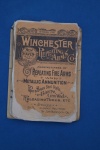
|
Winchester 1892 Saddle Ring Carbine in .44 WCF with Early Antique SN# |
This is a good example of an early Model 1892 Winchester carbine in .44 caliber that once worked for a living. During the 19th century, most saddle ring carbines were used as tools and utility weapons as they were built to be carried on horseback. While Winchester made plenty of 1892 carbines in the 20th century, their early production seemed to focus more on meeting the demand for aporting rifles. Thus, early production carbines are not as common as their rifle configured brothers and their conditions are usually worse. This one came to us several years ago from Texas and given the scabbard wear and use it received, I am convinced it once belonged to a real 19th/early 20th century cowboy. It's in the 23,000 serial range and would have been manufactured in either 1893 or 1894. Standard configuration with saddle ring, carbine post and ladder sights, semi-crescent carbine style buttplate, 20" barrel, full magazine, in caliber .44 WCF (a.k.a. 44-40). It's early enough that has the solid block style front sight as found on the Model 1873 carbine. In contrast, later production 1892 carbines were slotted for German silver blades followed by steel ones. Overall Condition grades to NRA Antique Good Plus. The metal has turned to a dark patina that is fairly smooth overall with the exception of some areas of light pitting (mostly on the high spots) from being kept in a leather scabbard which exposed it to moisture. There are slight traces of original blue in protected areas like below the receiver flairs, a little on the top of the bolt ahead, down in donut hole of the wear shadow of the saddle ring and slightly above it. There is also a little blue on the base of the rear sight. This is the original factory barrel with all the markings in the right places and not a later replacement. This includes the early two line barrel address at 12 o'clock, the "44 W.C.F." behind the rear sight...also at 12 o'clock. The solid block style front sight is also correct for an early production carbine. The bore is in Good++ to VG condition with strong rifling, a few scattered pits but no rough patches, and most importantly, no rings or bulges. Rear sight has the proper 200 to 900 yard graduations. Following the introduction of the Model 1892, around 1893, Winchester removed the "1873" designation at the top of the sight ladder...this one doesn't have it which is correct for both a Model 1873 and 1892 carbine produced in circa '93 or '94. The upper tang has the correct early style three lines with the Mfr, Model, and original John Browning 1884 patent date. The hammer has the earliest style checkered knurling with the Victorian-style decorative dipped border. See photo. These hammers were used for just the first few years of production and they seem to mostly fade out in the 40-50,000 serial range and replaced with a simpler rectangular pattern. Still, from personal experience, I've seen a few stragglers of the early pattern on 1892's as high as the 70,000-75,000 serial range. Another nice feature found on early Model 1892's are the walnut stocks. This carbine has fairly nice wood for a saddle gun although the forend shows a bit of scabbard wear as well as some abuse around the rear barrel band and front of the forewood where it appears that a frustrated cowboy was trying his best to remove it. My guess is that he was probably trying to get the magazine tube off to clear out a jam or obstruction. He was really having a hard time and probably ran out of patience. You can almost hear him..."DAG GUMMIT, Sonuvahh Horse Bit!!!!" Well, he ended up pulling on the tube in such a way that it put a couple of cracks in the forend which fortunately did not propogate too far. We were able to mend the cracks and the forewood is now solid as rock although you can still see that cowboy's rage from 100 years ago trying to get the band off the front of the forend. Like I said, this was a working man's gun and he treated it like a tool. The original stock is in a little better shape with a lot of nice open grain. The stock is solid with no cracks. There was one little 1/2" long chip up by the hammer (this is very common as the wood is very thin here) which we mended with a small piece of old walnut making it all but invisible now. The screws are all in good shape. Mechanics are nice...we got 120 years of dirt, old grease, and crud out of the action and it operates very smoothly now. All in all, this is a very colorful 1892 saddle ring with a lot of character. It's not a high end collector grade Winchester. These early examples are hard to find in original condition and to locate a decent one is an accomplishment in my book. So much so that we held onto this one for years. Besides, knowing this one came out of Texas, it was just too cool to sell right away! We have really enjoyed owning this little gun and I hope it will go to someone who will leave it just the way it is! Item# 1882 SOLD |
 |
 |
 |
 |
 |
 |
 |
|
 |
 |
 |
 |
 |
 |
 |
 |
 |
 |
 |
|
 |
 |
 |
 |
 |
 |
||
 |
 |